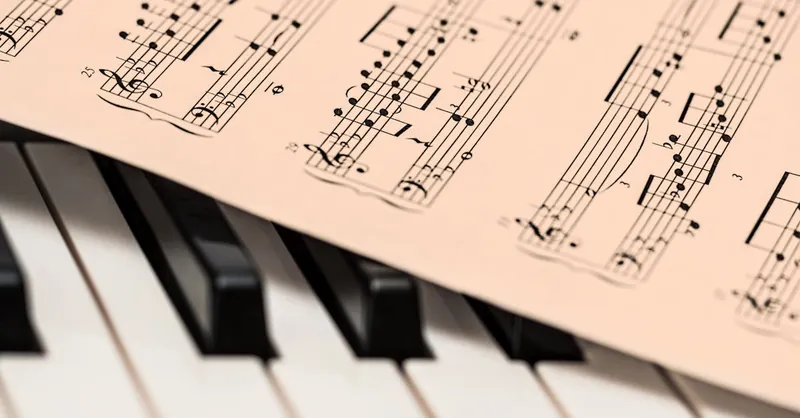Guitar Chord Progressions for Beginners: Simple & Clear Guide
Category: Music Theory
Master Guitar Chord Progressions Made Easy
If you've just picked up the guitar and feel overwhelmed by the endless string combinations and chord charts, you're not alone. Many beginners struggle to understand how to connect individual chords into smooth, musical progressions that actually sound good. You arrived here because you’re eager to break down complex music theory into bite-sized, practical lessons that build confidence—and fast. This post is crafted specifically for beginner musicians and music enthusiasts who want a straightforward, no-nonsense explanation of guitar chord progressions that you can apply immediately. Unlike other articles heavy on jargon or theoretical detours, we focus on clarity, actionable steps, and how these progressions work on guitar and piano alike. Whether you want to jam with friends or compose your own songs, learning these core progression patterns is your gateway to fluency on your instrument. Let’s move beyond confusion and give you the tools and understanding to play with purpose and creativity. By the end of this guide, you'll be able to recognize, practice, and even create common chord progressions confidently—so keep reading and get ready to transform how you play!
- Master Guitar Chord Progressions Made Easy
- Understanding the Basics: What Is a Chord Progression?
- Essential Guitar Chords for Beginners
- The Role of Scales and Keys in Chord Progressions
- Top 5 Simple Chord Progressions Every Beginner Should Know
- How to Practice Chord Progressions Effectively
- Common Mistakes to Avoid When Learning Progressions
- Using a Metronome and Rhythm Patterns to Enhance Progressions
- Applying Progressions on Piano: Bridging Guitar and Keyboard Basics
- Creating Your Own Simple Chord Progressions
- Recommended Songs to Practice These Progressions
Understanding the Basics: What Is a Chord Progression?
At its core, a chord progression is simply a sequence of chords played one after another, creating the harmonic foundation of a song. Think of it as the musical roadmap that guides the melody and rhythm, shaping the emotional journey of any piece of music. Whether you’re strumming an acoustic guitar or playing chords on the piano, chord progressions provide structure and coherence, turning isolated chords into a compelling musical story.
Why do chord progressions matter? Because they are the backbone of nearly all music genres, from pop and rock to jazz and blues. A well-crafted chord progression creates tension, release, and movement, making your music feel dynamic and engaging. For beginners on guitar and piano, understanding chord progressions is crucial—it helps you anticipate what chords might come next, improve your improvisation skills, and build the confidence to compose or jam with others. In short, mastering chord progressions unlocks a new level of musical fluency and creativity on your instrument.

Image courtesy of Tima Miroshnichenko
Essential Guitar Chords for Beginners
To start playing chord progressions confidently, it’s crucial to first master a set of basic guitar chords that form the foundation of countless songs. These beginner-friendly chords are easy to learn, sound great together, and open the door to playing a wide variety of musical styles. The most common essential chords include:
- C Major (C) – Known for its bright, open sound, C major is foundational in many progressions.
- G Major (G) – A versatile chord, often used to add richness and depth.
- D Major (D) – Adds a higher-pitched, melodic quality, perfect for transitions.
- E Minor (Em) – The easiest minor chord for beginners, Em adds emotional nuance.
- A Minor (Am) – A soft, melancholic chord essential for minor key progressions.
Tips for Fingering These Chords
- Position your fingers close to the frets to minimize buzzing and achieve a clear tone.
- Use the tips of your fingertips to press strings cleanly without touching adjacent strings.
- Keep your thumb behind the neck for good support and better mobility.
- Relax your hand muscles to avoid tension that slows chord changes.
Smooth Transitions Between Chords
Smooth chord changes are a key skill in playing enjoyable progressions. Practice transitioning between these chords slowly, focusing on:
- Minimizing finger movement by finding common fingers between chords.
- Anticipating the next chord shape before striking the strings.
- Keeping a steady strum or rhythm to maintain momentum.
For example, moving between G and C often lets your ring finger remain close to its position, while the index and middle fingers shift accordingly. Developing these small habits will help your chord transitions become fluid and natural, making your chord progressions sound cohesive and musical.
By mastering these essential chords and focusing on smooth fingering techniques, you'll build a solid foundation to explore endless chord progressions that make playing guitar exciting and rewarding.

Image courtesy of Yan Krukau
The Role of Scales and Keys in Chord Progressions
Understanding the relationship between scales, keys, and chord progressions is vital for beginners aiming to create or recognize harmonically pleasing music. At its core, a key defines the group of notes and chords that naturally sound good together because they share a common scale — usually a major or minor scale. For example, if you’re playing in the key of C major, your primary chords will be derived from the C major scale’s seven notes: C, D, E, F, G, A, and B. Each of these notes forms the root of specific chords that “fit” together to create a harmonious progression.
How Scales Influence Chord Choices
Every chord in a progression is built from the notes of a specific scale, and the key determines which chords are naturally available and sound consonant. This explains why certain chord combinations feel resolving and pleasant, while others might sound jarring or unexpected.
- Major keys typically use chords built on the major scale degrees, such as I, IV, and V major chords, which serve as the foundation for countless songs.
- Minor keys use chords based on the natural minor scale or its variations, introducing minor and diminished chords that lend a more emotional or somber tone.
Why Keys Matter for Beginners
When you know the key of a song or progression, you can quickly identify which chords are likely to appear, making it easier to anticipate changes and improvise. For beginner guitarists and pianists, this means you can:
- Predict chord progressions using scale-based patterns, simplifying learning and memorization.
- Experiment confidently with chord substitutions that fit the key, adding variety to your playing.
- Compose original music that sounds balanced and intentional by following key-based rules.
In short, scales and keys act as the “grammar” of music, guiding your chord choices and ensuring your progressions sound unified rather than random. Embracing this concept early accelerates your musical intuition and deepens your understanding of why some chords just belong together.

Image courtesy of Pixabay
Top 5 Simple Chord Progressions Every Beginner Should Know
Now that you’ve grasped the basics of chords, scales, and keys, it’s time to dive into the most popular and versatile guitar chord progressions that every beginner should master. These progressions form the backbone of countless hit songs across genres and are perfect for practicing smooth transitions and developing your musical ear. Below, you'll find the top 5 essential chord progressions with clear diagrams and practical playing tips to get you jamming right away.
1. The Classic I-IV-V Progression
The I-IV-V progression is arguably the most iconic and widely used progression in music, especially in rock, pop, and blues. In the key of C major, this means playing:
| Chord | Degree | Notes |
|---|---|---|
| C | I | C - E - G |
| F | IV | F - A - C |
| G | V | G - B - D |
Why it matters: This progression creates a strong sense of resolution and movement, making it perfect for beginners wanting to feel the push and pull of harmony. Try strumming each chord for four beats and focus on the fluid transitions between C, F, and G.
2. The Emotional vi-IV-I-V Progression
Known for its emotional pull and common use in many pop ballads, the vi-IV-I-V progression combines a minor chord (vi) with major chords for a bittersweet sound. In C major, this translates to:
| Chord | Degree | Notes |
|---|---|---|
| Am | vi | A - C - E |
| F | IV | F - A - C |
| C | I | C - E - G |
| G | V | G - B - D |
Playing tip: Practice this progression slowly at first, ensuring clear ringing notes on each chord. It works beautifully with fingerpicking or gentle strumming, perfect for adding emotion to your playing.
3. The Timeless I-vi-IV-V Progression
Also called the “50s progression” or “doo-wop progression,” the I-vi-IV-V has a nostalgic, catchy feel. In C major:
| Chord | Degree | Notes |
|---|---|---|
| C | I | C - E - G |
| Am | vi | A - C - E |
| F | IV | F - A - C |
| G | V | G - B - D |
Why practice this progression: Its repetitive nature makes it excellent for building muscle memory and understanding common chord relationships.
4. The Soothing I-V-vi-IV Progression
Extremely popular in modern pop music, the I-V-vi-IV progression offers a smooth harmonic flow that sounds complete and satisfying. For C major:
| Chord | Degree | Notes |
|---|---|---|
| C | I | C - E - G |
| G | V | G - B - D |
| Am | vi | A - C - E |
| F | IV | F - A - C |
Practice advice: Use a steady strumming pattern and listen to how the chords “tell a story” with movement and resolution.
5. The Folk-Friendly I-IV-vi-V Progression
This progression is common in folk and country styles, blending major and minor chords for a warm sound. In C major:
| Chord | Degree | Notes |
|---|---|---|
| C | I | C - E - G |
| F | IV | F - A - C |
| Am | vi | A - C - E |
| G | V | G - B - D |
Tips for beginners: Focus on smooth finger placement, and experiment with different strumming or fingerpicking rhythms to find your style.
Practical Playing Advice to Master These Progressions
- Use a metronome: Start slow to build accuracy and timing.
- Loop progressions: Repeating these sequences helps internalize chord shapes and transitions.
- Focus on chord ring-outs: Make sure all strings ring clearly for a full-sounding progression.
- Experiment within the key: Try playing these progressions in other keys like G or D to expand your versatility.
By learning and practicing these top 5 chord progressions, you’ll quickly develop your ability to play songs, jam with others, and understand harmonic flow on both guitar and piano. These foundational patterns will also prepare you to recognize common progressions in music you listen to, deepening your musical intuition and enjoyment.

Image courtesy of Photo By: Kaboompics.com
How to Practice Chord Progressions Effectively
Mastering guitar chord progressions isn’t just about knowing the chords—it’s about developing the ability to switch between them smoothly while keeping consistent rhythm and timing. For beginners, establishing an effective practice routine can make all the difference in accelerating progress and building confidence. Here are key strategies to practice chord progressions efficiently, helping you improve chord changes, rhythm, and musical timing.
1. Break Down Progressions Into Smaller Segments
Start by practicing transitions between just two chords at a time. For example, focus on shifting back and forth between C major and G major before attempting a full four-chord progression. This targeted approach helps build muscle memory for specific finger movements and reduces frustration.
2. Use a Slow and Steady Tempo With a Metronome
Rhythm and timing are essential components of playing chord progressions smoothly. Practice with a metronome set to a slow tempo to keep a steady beat. Strum or pick each chord along with the metronome clicks, gradually increasing the speed as your accuracy improves. This trains both your coordination and internal sense of timing, which are crucial for playing with others or accompanying songs.
3. Focus on Clear Ringing Notes and Finger Placement
Ensure every string in a chord rings clearly by pressing firmly and positioning your fingers correctly. Muted or buzzing strings often signal incorrect finger angles or tension. Consistent practice with attention to tone quality reinforces good habits that translate into cleaner sound as you play progressions.
4. Incorporate Rhythm Variations and Strumming Patterns
Once chord changes feel natural, experiment with different strumming patterns and rhythmic accents to make your progressions more musical and dynamic. Practicing with varied rhythms helps break monotony and improves your overall sense of groove and timing.
5. Build Practice Sessions Around Repetition and Patience
Repetition is key to mastery. Set aside short, regular practice sessions focusing solely on chord progressions. Even 10–15 minutes of focused practice daily can dramatically improve your fluidity. Be patient—smooth transitions and rhythm control develop incrementally over time.
By combining these structured practice techniques, beginners can develop strong foundational skills in chord transitions, rhythm, and timing. This lays the groundwork for playing songs confidently and exploring more complex progressions on both guitar and piano. Remember, intentional practice with clear goals is the fastest path from awkward chord changes to musical fluency.

Image courtesy of SHVETS production
Common Mistakes to Avoid When Learning Progressions
When starting out with guitar chord progressions, it’s easy to fall into habits that can slow down your progress or cause frustration. Recognizing and correcting these common beginner mistakes will set you up for faster improvement and more enjoyable practice sessions.
1. Rushing Chord Changes Before You’re Ready
One of the most frequent issues is trying to switch chords too quickly without solid finger placement or clear notes. Rushing leads to sloppy transitions, muted strings, and inconsistent rhythm. Instead, focus on slow, deliberate chord changes where every note rings out clearly. Use a metronome at a slow tempo to build confidence before gradually increasing speed.
2. Poor Hand Positioning and Finger Placement
Incorrect hand posture and finger angles can cause buzzing strings, hand fatigue, and difficulty reaching chord shapes. Beginners often grip the neck too tightly or let their fingers lay flat, muting adjacent strings unintentionally. To avoid this:
- Keep your thumb centered behind the guitar neck for better leverage.
- Use the tips of your fingers to press strings firmly and cleanly.
- Maintain a relaxed wrist and avoid excess tension.
Good hand positioning improves sound quality and makes chord transitions smoother and less tiring.
3. Neglecting the Importance of Rhythm
Even perfectly played chords can sound off if the rhythm isn’t steady or expressive. Beginners sometimes focus solely on chord shapes and forget to maintain a consistent strumming pattern or timing, which disrupts the musical flow. Practicing with a metronome or tapping your foot helps develop an internal pulse, ensuring your chord progressions groove rhythmically alongside other instruments or backing tracks.
By deliberately avoiding these pitfalls—rushing chord switches, poor hand posture, and ignoring rhythm—you’ll build a strong technical foundation. These habits not only enhance your guitar skills but also translate well to piano chord progressions, deepening your overall music theory and performance capabilities. Remember, slow and mindful practice is the key to mastering fluid, musical chord progressions on any instrument.

Image courtesy of SHVETS production
Using a Metronome and Rhythm Patterns to Enhance Progressions
Mastering guitar chord progressions goes beyond simply knowing which chords to play—it requires developing a solid sense of timing, rhythm, and groove. This is where practicing with a metronome and experimenting with rhythm patterns become invaluable tools for beginners. A metronome provides a consistent, steady pulse, helping you internalize the beat so your chord changes happen exactly on time. This consistency is essential for playing with other musicians or backing tracks and for creating smooth, flowing progressions that feel natural.
How to Practice Progressions with a Metronome
- Set a slow tempo: Begin at a comfortable speed where you can change chords cleanly and on time.
- Strum or pick in time: Play each chord in sync with the metronome clicks, allowing the sound of the clicks to guide your rhythm.
- Increase tempo gradually: Only speed up once your chord changes and strumming remain steady and clear.
- Focus on downbeats and upbeats: Experiment by strumming on the beats (downbeats) or in-between (upbeats) to develop dynamic rhythm control.
Rhythm Patterns to Try with Basic Progressions
Integrating simple strumming patterns adds life and musicality to your playing. For beginners, starting with these common patterns can improve your groove and timing:
- Downstrokes only: Play one strum per metronome click for fundamental timing practice.
- Down-Up pattern: Alternate down and up strums per beat (e.g., “down-up, down-up”) to create smooth, flowing rhythms.
- Syncopated rhythms: Add accents off the beat to make your playing more interesting and develop a better feel for groove.
Mastering these rhythmic techniques alongside your chord progressions accelerates your musical development by connecting technical skills with expressive timing. Whether you’re strumming a simple I-IV-V or fingerpicking the vi-IV-I-V progression, combining metronome practice with varied rhythm patterns will make your guitar playing more confident, engaging, and rhythmic—skills that translate equally well to piano and other chordal instruments.

Image courtesy of Yan Krukau
Applying Progressions on Piano: Bridging Guitar and Keyboard Basics
One of the most powerful ways to deepen your understanding of chord progressions is to apply the same concepts across instruments—especially between guitar and piano. Since both instruments share the same underlying music theory principles, translating guitar chord progressions onto the piano is a highly effective method to reinforce your harmonic knowledge and improve your overall musicianship.
How Guitar Chord Progressions Translate to Piano
The chords you play on guitar correspond to the same chord shapes and functions on piano, just voiced differently. For example, the classic I-IV-V progression in C major (C–F–G) uses the same notes on both instruments, but on piano, you play these chords using combinations of white keys organized in triads:
- C major (C–E–G)
- F major (F–A–C)
- G major (G–B–D)
Playing these progressions on piano allows you to visualize note relationships on a linear keyboard layout, which can clarify how chords are constructed from scales and how they relate to each other within a key.
Benefits of Cross-Instrument Practice for Beginners
- Reinforces Music Theory Concepts: Seeing and hearing the identical chord progression in both guitar shapes and piano triads helps solidify your understanding of chords, scales, and key relationships.
- Enhances Ear Training: Switching between instruments trains you to recognize chord sounds regardless of timbre or shape, developing a more versatile musical ear.
- Improves Improvisation and Composition Skills: Knowing how chord progressions function on both guitar and piano broadens your creative toolkit, making it easier to write, arrange, or improvise music.
- Builds Technical Flexibility: Practicing the same progressions fingered differently on guitar and piano develops finger independence and dexterity in both hands.
Practical Tips for Beginners Using Both Instruments
- Start with simple chord progressions like I-IV-V or vi-IV-I-V on guitar, then replicate them on piano using basic triads.
- Use both hands on the piano to play root notes with the left hand and chords with the right hand to mimic strumming or picking on guitar.
- Experiment with different voicings and inversions on piano to hear how chord shapes can vary while maintaining the same harmonic function.
- Record yourself playing on both instruments and compare how the progressions sound, focusing on clarity and smooth transitions.
By bridging guitar and piano basics through shared chord progressions, beginners open the door to a more comprehensive and intuitive grasp of music theory. This cross-instrument approach not only boosts your confidence in playing but also accelerates your journey toward becoming a skilled, versatile musician capable of navigating any musical context with ease.

Image courtesy of Tima Miroshnichenko
Creating Your Own Simple Chord Progressions
Once you’ve mastered basic chords and common progressions, the next exciting step is building your own simple chord progressions. This empowers you to move beyond playing songs written by others and start composing music that reflects your personal style. By applying fundamental music theory principles—especially the concepts of keys, scales, and chord functions—you can confidently create progressions that sound harmonious and engaging on both guitar and piano.
Steps to Build Your Custom Chord Progressions
-
Choose a Key to Work In
Selecting a key, such as C major or G major, provides a palette of chords derived from that key’s scale. Sticking to the key ensures your progression will sound cohesive. For example, in C major, chords are built from the notes C, D, E, F, G, A, and B, giving you a set of chords like C major (I), D minor (ii), E minor (iii), F major (IV), G major (V), A minor (vi), and B diminished (vii°). -
Understand Chord Functions
Each chord within a key serves a harmonic function: - Tonic (I, vi): Provides a sense of rest and resolution.
- Subdominant (ii, IV): Creates movement away from the tonic, adding tension.
-
Dominant (V, vii°): Builds tension that typically resolves back to the tonic.
-
Start Simple with Three or Four Chords
Begin by combining tonic, subdominant, and dominant chords. For example, a progression like I–IV–V–I (C–F–G–C in C major) creates a natural musical flow. You can also try substituting the vi chord for a minor flavor (e.g., I–vi–IV–V). -
Experiment with Chord Order and Repetition
Play around with the sequence and repetitions of chords to craft different moods. For instance, repeating the IV chord before moving to V can build anticipation, while starting on vi offers a more melancholic tone. -
Listen and Adjust
Trust your ear to decide whether the progression feels balanced or needs tweaking. Try strumming or playing your progression on guitar or piano repeatedly, and notice the emotional effect it produces. Adjust chords or add passing chords (like ii or iii) to enrich your progression.
Encouraging Creativity and Independence
Creating your own chord progressions not only deepens your practical understanding of music theory fundamentals but also fosters musical creativity and independence. By learning how chord functions interact and how scales shape chord choices, you gain confidence to compose melodies, write songs, and even explore improvisation on guitar and piano. This hands-on approach accelerates your journey from beginner to a versatile musician capable of crafting your unique sound.
Through this structured yet creative method of building chord progressions with basic music theory tools, beginners develop valuable skills that unlock endless possibilities. Whether you decide to write heartfelt ballads, catchy pop tunes, or soulful blues riffs, creating your own chord progressions is the key to expressing yourself and advancing your musicianship on both guitar and piano.

Image courtesy of Pavel Danilyuk
Recommended Songs to Practice These Progressions
Putting theory into practice is essential for building confidence and musicality. To help you connect the guitar chord progressions covered in this guide with real music, here are some beginner-friendly songs that feature these exact progressions. Learning these tunes will not only improve your chord switching skills but also deepen your understanding of how progressions create emotional and rhythmic impact in popular music.
Songs Featuring the I-IV-V Progression
- "Twist and Shout" by The Beatles
A classic rock and roll anthem that uses the I-IV-V progression in a driving, energetic way, perfect for practicing quick chord changes and steady strumming. - "La Bamba" by Ritchie Valens
This vibrant folk-rock song cycles through the I-IV-V chords, making it an excellent choice for beginners seeking lively rhythm practice.
Songs Using the vi-IV-I-V Progression
- "Let It Be" by The Beatles
This timeless ballad beautifully showcases the emotional vi-IV-I-V progression, allowing beginners to experience how minor and major chords blend to create depth. - "With or Without You" by U2
A modern rock classic emphasizing smooth transitions between these chords with a consistent, flowing rhythm.
Songs Featuring the I-vi-IV-V Progression
- "Stand By Me" by Ben E. King
This soulful tune is an iconic example of the “50s progression,” great for practicing chord changes at a relaxed tempo. - "Earth Angel" by The Penguins
A doo-wop classic that uses this progression to create nostalgic charm, ideal for fingerpicking or gentle strumming patterns.
Songs Using the I-V-vi-IV Progression
- "Counting Stars" by OneRepublic
A contemporary pop hit with a catchy groove, this song helps beginners explore rhythm variations over a familiar chord pattern. - "Someone Like You" by Adele
An emotional ballad that uses the I-V-vi-IV progression with poignant dynamics, perfect for practicing expressive strumming or piano accompaniment.
Songs Featuring the I-IV-vi-V Progression
- "Wagon Wheel" by Old Crow Medicine Show
A widely loved folk-country tune that invites learners to combine major and minor chords with a laid-back strumming style. - "Brown Eyed Girl" by Van Morrison
A feel-good classic incorporating this progression, helping beginners build endurance and timing through repeated chord cycles.
Why Practice Songs with These Progressions?
- Connect Theory and Sound: Playing recognizable songs makes abstract progressions tangible, enhancing your musical intuition.
- Improve Muscle Memory: Repetitive chord sequences in songs reinforce smooth transitions and finger positioning.
- Develop Rhythm and Timing: Songs naturally incorporate rhythm patterns and tempo changes that boost your timing skills.
- Stay Motivated: Learning songs you enjoy keeps practice engaging and rewarding, accelerating your progress.
By integrating these beginner-friendly songs into your practice routine, you’ll solidify your grip on essential chord progressions and gain the confidence to play and create music that resonates. Whether on guitar or piano, translating theory into familiar tunes is a powerful way to elevate your musicianship and enjoy the learning journey.

Image courtesy of Yan Krukau
